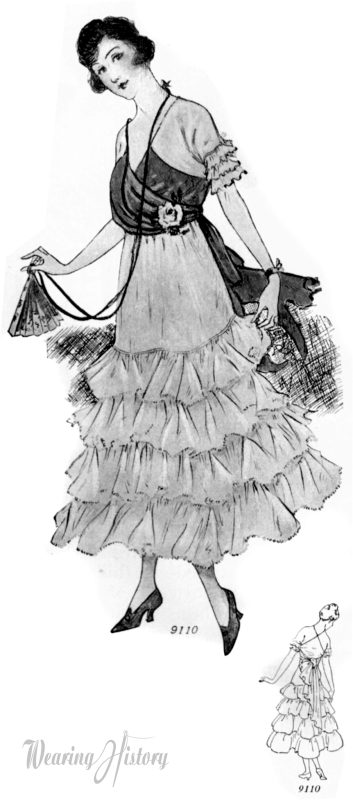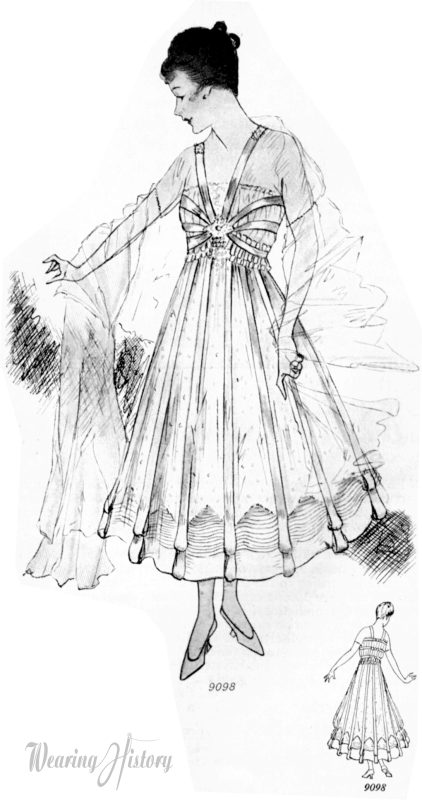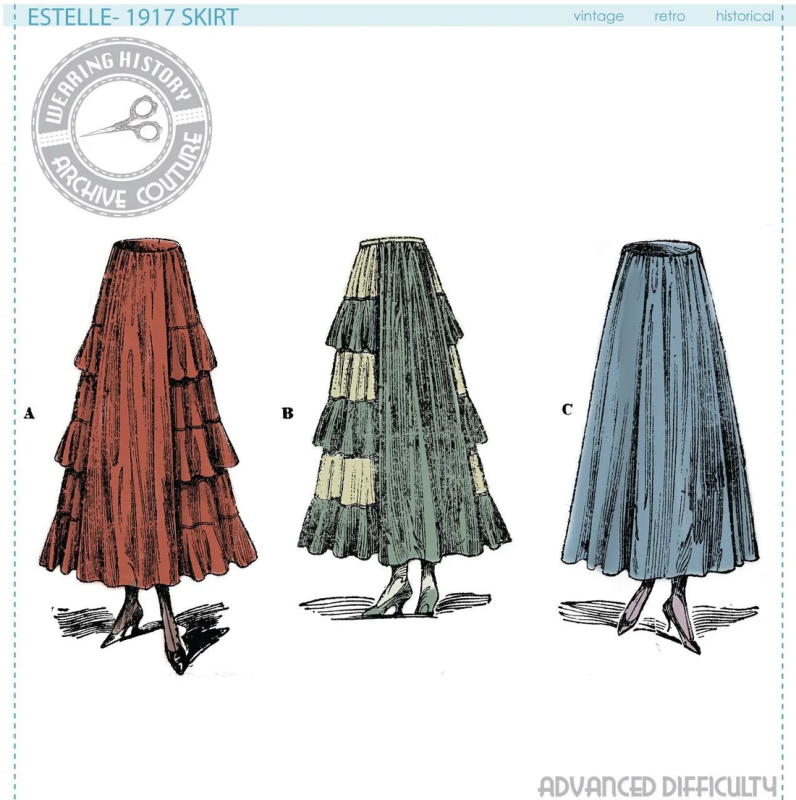This article comes from the October, 1915 issue of the Ladies Home Journal.
Some of us who love our 1910s fashion recognize the year 1916 as a sort of “historical throwback” year, where hoops made a quick comeback (sometimes called the “war crinoline”), and women’s dress often resembled a fluffy, romanticized, mid-Victorian aesthetic. Well, this article is interesting in that it pre-dates those dresses by a year, and this article was made for mass-market appeal. All dresses on this page had Home Patterns that could be mailed away for (as they were the pattern line for this magazine)! Even without high fashion access, the everyday woman could make these gowns tailored to her needs and her own figure.
Of particular interest, one of the designs had a build in pannier, which came to be known as the “Robe de Style” in the 1920s, popularized by Jeanne Lanvin. The pannier style was earlier than many realize!
“Scorning Even Ankle Length, These Skirts Widen Audaciously”


With but a minimum of length, and a maximum of trimming and material is in the skirt whether for the dance or for the less frivolous hours, as these pretty frocks prove. Beginning at the scantily furred collar of the white broadcloth afternoon gown on the left (No 9112), the soutache briefly zigzags its intricate course down the center of the waist, applying itself more liverally below the belt, where it simulates what this on-piece circular-skirted gown lacks- a rounded hip yoke.

Beginning below an airy flesh pink tulle yoke, which veils but conceals not the pretty shoulders on the right (No 9110), the pointed surplice of azure-blue taffeta ends in a sash centering in back and overhanging the three-piece gathered skirt. It is reminiscent of the early Victorian modes by its many fluffy ruffles, all of which are of the same will-o’-the-wisp texture of which the yoke of this one in particular and dance dresses in general are made.

Of shimmering gray satin is the bewitching dance frock below on the left (No 9113), presaging with its voluminous skirt the return of the bouffant pannier, with all its waist familiarly surpliced, and what little it has of sleeves caught by a bracelet of pearls. Over the three-piece foundation floats the circular tulle overskirt, girdled and weighted at its hem with pearls and with here and there opalescent dragon flies incrusted with pearls and glowing beads.

Being plaited full where fullness must not be, the delightfully short bodice of this adorable dress on the right (No 9098) is many times restrained with narrow satin ribbons, radiating from a jeweld ornament at the front and edging the transparent shoulder yoke. In long lines ended by soft loops, it regularly strips the width of the three-piece gathered skirt of spangled net, the hem of which is marked by threads of beads.
Patterns (including Guide-Chart) for the designs shown on this page can be supplied at fifteen cents for each number, post-free. Nos 9098, 9110, and 9113 come in six sizes, 32 to 42 inches bust measure, and No 9112 comes in sizes 34 to 42 inches bust measure. If there is no agency for Home Patterns in your town, patterns of any numbered designs shown in The Ladies Home Journal may be had by mail by stating the number and size and inclosing the price to… etc etc.
The autumn number of the Home Book of Fashions is on sale at every branch office for Home Patterns at twenty five cents a copy, etc etc.

The dresses particularly remind me of my favorite dress of all time, the “Happiness” dress by Lucile, made Fall of 1916. This image comes from the Philadelphia Museum of Art.
I even made my own version of the dresses in these early “pannier” styles for Costume College one year, when a group of us made Rode de Style inspired gowns.

You can read more about that dress here.
I intended to cover the entire dress in roses, and make a metalwork basket to be visible underneath the gold skirt, but I never did finish that project! Maybe someday my daughter will be the right size, and I can finish it up for her to wear. I just realized I made this dress ten years ago!

If you would like to get a similar look as the fashion page, you can adapt this pattern, from 1917, to a dress in this style. This particular skirt has a 26″ waist. Wearing History “Estelle” 1917 skirt, taken from a period original.

For a similar bodice, you can adapt this bodice, from 1919, for a similar look. The top two line drawings show styles in line with earlier 1910s blouses. This is the “Gloria” Wearing History pattern, available in size 34″ bust, taken from a period original.
Well, that’s about all the news here. For my fourty-somethingth birthday, my “present” was my optometrist telling me I need progressive lenses, so I’m typing this half-sightedly while I wait for my new glasses to arrive. I hope to be back to blogging more once I can see properly again!
Hope all are doing well, and Happy Autumn!

Nicole
October 8, 2024 at 9:54 pm (9 months ago)How audacious! I love this dress silhouette and have always thought it rather fun. I love your version too.